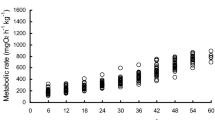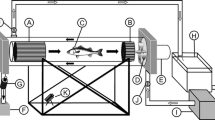Summary
The spontaneous swimming activity and oxygen consumption of juvenile roach (Rutilus rutilus (L.)), were monitored for 48–72 h at 8, 15 and 20°C and a photoperiod (L:D) of 11:13. At low levels of activity metabolic cost is constant and thus corresponds to the standard rate of metabolism (“low cost” activity). At higher levels of activity metabolic cost increases in proportion with the degree of activity. The slope for this “high cost” activity indicates an expenditure of 0.4–1.3 μmol O2·g-1·h-1 per arbitrary activity unit at the three experimental temperatures. Extrapolation of this relationship to zero activity would underestimate the measured standard metabolic rate. “High cost” activity occurred in only one experiment out of three at 8°C, “low cost” activity hardly at all at 20°C, whereas at 15°C both forms of activity were present in five of the seven experiments conducted. Thus, not only the intensity but also the pattern of activity is affected by environmental temperature.
Similar content being viewed by others
References
Bartlett MS (1949) Fitting a straight line when both variables are subject to error. Biometrics 5: 207–212
Beamish FWH (1964) Respiration of fishes with special emphasis on standard oxygen consumption. II. Influence of weight and temperature on respiration of several species. Can J Zool 42: 177–188
Beamish FWH (1978) Swimming. In: Hoar WS, Randall DJ (eds) Fish physiology, vol. VII. Academic Press, New York, pp 101–189
Beamish FWH, Mookherjii PS (1964) Respiration of fishes with special emphasis on standard oxygen consumption. I. Influence of weight and temperature on respiration of goldfish, Carassius auratus L. Can J Zool 42: 161–175
Brett JR (1964) The respiratory metabolism and swimming performance of young sockeye salmon. J Fish Res Board Can 21: 1183–1226
Brett JR (1965) The relation of size to rate of oxygen consumption and sustained swimming speed of sockeye salmon (Oncorhynchus nerka). J Fish Res Board Can 223: 1491–1501
Cairns JJR, Thompson KDB (1980) A computer interfaced toxicity testing system for simulating variable effluent loading. In: Levins PL, Harris JC, Drewitz KD (eds) Second symposium on process measurement for environmental assessment. Mass.: AD Little Inc, Cambridge, pp 183–198
Febry R, Lutz P (1987) Energy partitioning in fish: activity-related cost of osmoregulation in a euryhaline cichlid. J Exp Biol 128: 63–85
Fry FEJ (1971) The effect of environmental factors on the physiology of fish. In: Hoar WS, Randall DJ (eds) Fish physiology, vol. VI. Academic Press, New York, pp 1–99
Holeton GF (1980) Oxygen as an environmental factor of fishes. In: Ali MA (ed) Environmental physiology of fishes. Plenum Press New York and London, pp 7–32
Kaufmann R (1983) VAMP: a video activity monitoring processor for the registration of animal locomotor activity. J Exp Biol 184: 295–298
Kaufmann R, Forstner H, Wieser W (1989) Respirometry — methods and approaches. In: Bridges CR, Butler PJ (eds) Techniques in comparative respiratory physiology: an experimental approach. Society for Experimental Biology Seminar Series. Cambridge Univ Press, Cambridge, pp 51–76
Kausch H (1968) Der Einfluß der Spontanaktivität auf die Stoffwechselrate junger Karpfen (Cyprinus carpio L.) im Hunger und bei Fütterung. Arch Hydrobiol Suppl 33: 263–330
Koch F (1984) Der Einfluß von Temperature, Jahreszeit und Schwarmgröße auf den Sauerstoffverbrauch von Rotaugen, Rutilus rutilus (L.). Thesis, University of Innsbruck, Austria
Koch F, Wieser W (1983) Partitioning of energy in fish: can reduction of swimming activity compensate for the cost of production? J Exp Biol 107: 141–146
Oertzen JA von (1985) Resistance and capacity adaptation of juvenile silver carp, Hypophthalmichthys molitrix (Val.) to temperature and salinity. Aquaculture 44: 321–332
Ricker WE (1973) Linear regressions in fishery research. J Fish Res Board Can 30: 409–434
Smit H (1965) Some experiments on the oxygen consumption of goldfish (Carassius auratus L.) in relation to swimming speed. Can J Zool 43: 623–633
Spoor WA (1946) A quantitative study of the relationship between the activity and oxygen consumption of goldfish, and its application to the measurement of respiratory metabolism in fishes. Biol Bull 91: 312–325
Steffensen JF (1989) Some errors in respirometry of aquatic breathers: how to avoid and correct for them. Fish Physiol Biochem 6: 49–59
Webb PW (1975) hydrodynamics and energetics of fish propulsion. Bull Fish Res Board Can 190: 1–158
Wieser W (1973) Temperature relations of ectotherms: a speculative review. In: Wieser W (ed) Effects of temperature on ectothermic organisms. Springer, Berlin Heidelberg New York, pp 1–23
Author information
Authors and Affiliations
Rights and permissions
About this article
Cite this article
Forstner, H., Wieser, W. Patterns of routine swimming and metabolic rate in juvenile cyyprinids at three temperatures: analysis with a respirometer-activity-monitoring system. J Comp Physiol B 160, 71–76 (1990). https://doi.org/10.1007/BF00258764
Accepted:
Issue Date:
DOI: https://doi.org/10.1007/BF00258764




